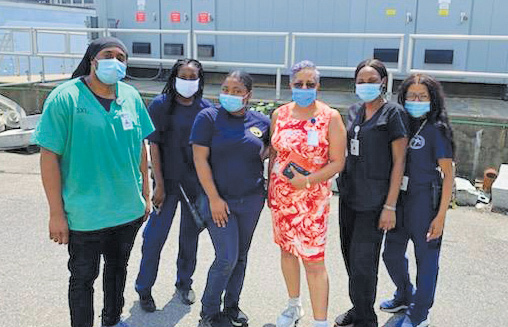Public Employee Press: PEP Talk
Local 420
Morgue Techs on the COVID-19 frontlines



By DIANE S. WILLIAMS
As part of New York’s response to the COVID-19 pandemic, Paramedics in Local 2507 help transport the living and those sickened by the deadly virus, while City Morgue Technicians in Local 420 who work at the Office of the Chief Medical Examiner (OCME) and in Health+Hospitals morgues are called on to bring out the dead.
“After my first few runs, I learned how to spot the COVID victims. When my partner and I would arrive, the COVID bodies were different. Their faces were often covered in a lot of blood and mucus, their mouths leaked body fluids. You could see where they just could not breathe,” said City Morgue Technician Efrain Santos, a 20-year employee hired a few days after the Sept. 11th terrorist attacks.
Santos works with a driver and together they carry out corpses. They are one of dozens of pairs of CMTs dispatched by OCME to collect the thousands of New Yorkers who died during the deadliest pandemic in a century. They transported the cadavers to either the OCME morgue or a makeshift morgue at the Brooklyn Navy Yard where the dead were being stored until they could be buried or cremated.
The world quickly saw firsthand how naive assumptions and ignoring the science regarding this microorganism would infect 9 million worldwide, 247,000 in New York City, and cost nearly 207,000 Americans their lives.
OCME mandated CMTs, like other COVID-19 responders, to work 12-hour shifts, six and sometimes seven days a week. Each CMT pair picked up almost a dozen bodies a day.
“It was overwhelming. I trembled at what I saw. It was scary and it was a lot,” Santos said. Although CMTs wore N-95 masks, face shields, thick gloves, and hazmat suits, Santos said, “I wore another pair of gloves under the thick gloves. I worked through 9/11, but this was far worse and more extensive. It was everywhere.”
People were literally dying in the streets, in public view. “We had to pick up a man in the middle of Park Avenue and East 77th Street,” Santos recalled. “He was just released from Lenox Hill Hospital, still had on his hospital admission wristband and he dropped dead just a few blocks away. It was us and the police at 8 a.m. in the middle of Park Avenue and we had to pick up the body. I will never forget that.”
OCME assigned all CMTs, including those who assist with autopsies, to retrieve bodies. The agency even added five more refrigerated trucks to its fleet of 10.
“Police were told not to go into the homes of the dead, so it was up to us to go in and retrieve the body,” Santos said. “OCME gave us a camera and told us to take pictures of the body as we found it. We logged them in, logged when we arrived at the scene, when we had custody of the body. It was a frightening experience that we were not prepared for. It was crazy.
“It hurt me to see the grieving families, especially the children crying over their parents. One daughter held on as we tried to take away her father’s body away. I fought back tears,” she said.
In some cases, the dead remained at home for two and three days until OCME could pick them up.
CMT Lamont Long, who joined OCME in 2006, usually assists with autopsies at the OCME on 1st Avenue in Manhattan. Due to the pandemic, he said autopsies were put on hold unless it was a homicide or overdose.
“I think if we didn’t have help from the Army Reserve and from funeral directors, we would still be picking up bodies,” Long said. “Compared to 9/11, the level of fear and emergency during COVID is much, much greater. We did not know how this virus was contracted. I did not want to get it and I definitely didn’t want to bring it home to my family.”
These and other concerns were raised by Local 420 President Carmen Charles on behalf of the 9,000 Local 420 members who work at NYC H+H public hosptials, long-term care facilities and clinics, and at the OCME.
Charles and DC 37 Executive Director Henry Garrido, along with other union leaders, are advocating to protect members’ health and jobs, as well as for hazard pay and other benefits for workers Mayor de Blasio has labeled as “essential”.
“As essential workers at OCME, we have a job to do, and we got it done,” Long said. “But it was a lot of work and at times it seemed almost too much to handle. This pandemic moved fast and I believe we were caught off guard.”
Charles said 120 members of Local 420 died after contracting the coronavirus and dozens more were sickened.
“In the long run, we do not know how this experience will affect us. It has changed every aspect of how we work and live,” Charles said. “We are looking to City Hall and Albany to take tangible steps to protect and support the dedicated workers who got us through the worst of this COVID-19 pandemic.”


